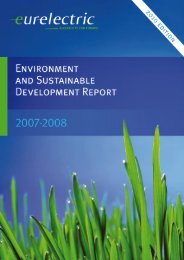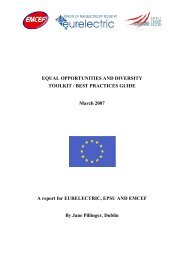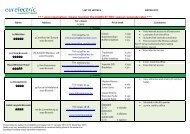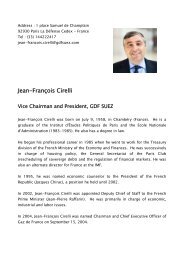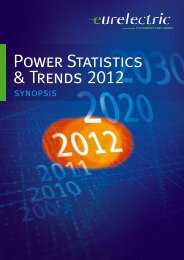Hydro in Europe: Powering Renewables - Full Report - Eurelectric
Hydro in Europe: Powering Renewables - Full Report - Eurelectric
Hydro in Europe: Powering Renewables - Full Report - Eurelectric
You also want an ePaper? Increase the reach of your titles
YUMPU automatically turns print PDFs into web optimized ePapers that Google loves.
The long life span of a hydro plant creates occasions where the balanc<strong>in</strong>g discussion between<br />
different needs has to be updated due to new general policies from society or change <strong>in</strong> local<br />
situations. For these reasons <strong>in</strong> most countries concessions are time bound <strong>in</strong> proportion to<br />
the amount of capital <strong>in</strong>vestment or the terms and conditions of the concessions can be<br />
revisited upon demand of the government.<br />
The evolv<strong>in</strong>g policy framework can create challenges as well as new opportunities for<br />
hydropower to contribute to a more susta<strong>in</strong>able development of <strong>Europe</strong>.<br />
In the follow<strong>in</strong>g chapter are discussed challenges related to EU policies such as the Directive<br />
(2009/28/EC) on the promotion of the use of energy from renewable sources (RES), the Water<br />
Framework Directive (WFD) and the security of water and energy supply.<br />
Other EU policy areas which are critical for the hydropower sector are:<br />
a) Flood risk assessment and management directive (2007/60/EC)<br />
b) White paper on water scarcity and droughts<br />
c) White Paper on climate change adaptation<br />
For the time be<strong>in</strong>g the above-mentioned three EU policy documents have largely<br />
ignored the role which hydropower reservoirs can play <strong>in</strong> flood/drought management<br />
and hence <strong>in</strong> adaptation to climate change. The learn<strong>in</strong>g process from a past, where<br />
these policies where much more conflict<strong>in</strong>g, has to be acknowledged.<br />
4.1 <strong>Hydro</strong>power fosters the achievement of <strong>Europe</strong>’s 2020 renewable energy targets<br />
This chapter presents the role of hydropower <strong>in</strong> the EU-27 towards achiev<strong>in</strong>g a 20%<br />
share of RES 40 <strong>in</strong> 2020. It first highlights the ma<strong>in</strong> RES objectives, and then focuses on<br />
RES electricity41 <strong>in</strong> order to present the role of hydropower <strong>in</strong> the future <strong>Europe</strong>an<br />
electricity mix.<br />
Renewable energy 2020 targets <strong>in</strong> EU-27<br />
The EU’s renewable energy policy is largely def<strong>in</strong>ed by its Renewable Energy Roadmap<br />
together with the <strong>Renewables</strong> Directive 42 (see Figure 18).<br />
40<br />
Renewable energy sources <strong>in</strong> this directive <strong>in</strong>clude 3 sectors: (i) electricity (RE-electricity), (ii) heat<strong>in</strong>g & cool<strong>in</strong>g<br />
(RE-H&C), and (iii) transport (RE-transport)<br />
41<br />
RE-electricity: hydropower ; geothermal ; solar PV, concentrated solar power ; tidal, wave and ocean energy ; onshore<br />
w<strong>in</strong>d, off-shore w<strong>in</strong>d ; solid biomass, biogas, bioliquids.<br />
42<br />
Directive 2009/28/EC “on the promotion of the use of energy from renewable sources and amend<strong>in</strong>g, and<br />
subsequently repeal<strong>in</strong>g Directives 2001/77/EC and 2003/30/EC<br />
49



